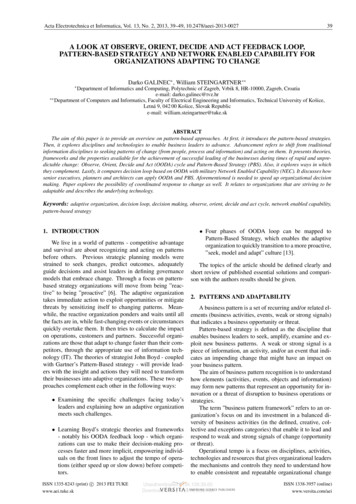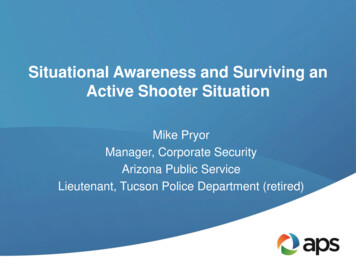
Transcription
Acta Electrotechnica et Informatica, Vol. 13, No. 2, 2013, 39–49, 10.2478/aeei-2013-002739A LOOK AT OBSERVE, ORIENT, DECIDE AND ACT FEEDBACK LOOP,PATTERN-BASED STRATEGY AND NETWORK ENABLED CAPABILITY FORORGANIZATIONS ADAPTING TO CHANGE DepartmentDarko GALINEC , William STEINGARTNER of Informatics and Computing, Polytechnic of Zagreb, Vrbik 8, HR-10000, Zagreb, Croatiae-mail: darko.galinec@tvz.hr Department of Computers and Informatics, Faculty of Electrical Engineering and Informatics, Technical University of Košice,Letná 9, 042 00 Košice, Slovak Republice-mail: william.steingartner@tuke.skABSTRACTThe aim of this paper is to provide an overview on pattern-based approaches. At first, it introduces the pattern-based strategies.Then, it explores disciplines and technologies to enable business leaders to advance. Advancement refers to shift from traditionalinformation disciplines to seeking patterns of change (from people, process and information) and acting on them. It presents theories,frameworks and the properties available for the achievement of successful leading of the businesses during times of rapid and unpredictable change: Observe, Orient, Decide and Act (OODA) cycle and Pattern-Based Strategy (PBS). Also, it explores ways in whichthey complement. Lastly, it compares decision loop based on OODA with military Network Enabled Capability (NEC). It discusses howsenior executives, planners and architects can apply OODA and PBS. Aforementioned is needed to speed up organizational decisionmaking. Paper explores the possibility of coordinated response to change as well. It relates to organizations that are striving to beadaptable and describes the underlying technology.Keywords: adaptive organization, decision loop, decision making, observe, orient, decide and act cycle, network enabled capability,pattern-based strategy1. INTRODUCTIONWe live in a world of patterns - competitive advantageand survival are about recognizing and acting on patternsbefore others. Previous strategic planning models werestrained to seek changes, predict outcomes, adequatelyguide decisions and assist leaders in defining governancemodels that embrace change. Through a focus on patternbased strategy organizations will move from being ”reactive” to being ”proactive” [6]. The adaptive organizationtakes immediate action to exploit opportunities or mitigatethreats by sensitizing itself to changing patterns. Meanwhile, the reactive organization ponders and waits until allthe facts are in, while fast-changing events or circumstancesquickly overtake them. It then tries to calculate the impacton operations, customers and partners. Successful organizations are those that adapt to change faster than their competitors, through the appropriate use of information technology (IT). The theories of strategist John Boyd - coupledwith Gartner’s Pattern-Based strategy - will provide leaders with the insight and actions they will need to transformtheir businesses into adaptive organizations. These two approaches complement each other in the following ways: Examining the specific challenges facing today’sleaders and explaining how an adaptive organizationmeets such challenges. Learning Boyd’s strategic theories and frameworks- notably his OODA feedback loop - which organizations can use to make their decision-making processes faster and more implicit, empowering individuals on the front lines to adjust the tempo of operations (either speed up or slow down) before competitors.ISSN 1335-8243 (print) c 2013 FEI TUKEwww.aei.tuke.sk Four phases of OODA loop can be mapped toPattern-Based Strategy, which enables the adaptiveorganization to quickly transition to a more proactive,”seek, model and adapt” culture [13].The topics of the article should be defined clearly andshort review of published essential solutions and comparison with the authors results should be given.2. PATTERNS AND ADAPTABILITYA business pattern is a set of recurring and/or related elements (business activities, events, weak or strong signals)that indicates a business opportunity or threat.Pattern-based strategy is defined as the discipline thatenables business leaders to seek, amplify, examine and exploit new business patterns. A weak or strong signal is apiece of information, an activity, and/or an event that indicates an impending change that might have an impact onyour business pattern.The aim of business pattern recognition is to understandhow elements (activities, events, objects and information)may form new patterns that represent an opportunity for innovation or a threat of disruption to business operations orstrategies.The term ”business pattern framework” refers to an organization’s focus on and its investment in a balanced diversity of business activities (in the defined, creative, collective and exceptions categories) that enable it to lead andrespond to weak and strong signals of change (opportunityor threat).Operational tempo is a focus on disciplines, activities,technologies and resources that gives organizational leadersthe mechanisms and controls they need to understand howto enable consistent and repeatable organizational changeUnauthenticated 194.138.39.60Download Date 1/15/14 2:58 AMISSN 1338-3957 (online)www.versita.com/aei
A Look at Observe, Orient, Decide and Act Feedback Loop . . .40in response to changing patterns [6].The aim of business pattern recognition is to understandhow elements (activities, events, objects and information)may form new patterns that represent an opportunity for innovation or a threat of disruption to business operations orstrategy [4].2.1. Adaptive organizationTo become adaptive from today’s organizations transition is required from reactive, ”sense and respond” decision styles to more proactive ”seek, model and adapt” environments. It is this ability to quickly find patterns, understand patterns and change patterns that becomes criticalfor success in today’s highly competitive, highly interconnected environments, where risk and uncertainty often prevail [13]. Adaptive Organizations have the Following Characteristics [17]: Modular: Modular organizational units that meettop standards and plug in where and when needed.This enables the firm to introduce and quickly implement product and process variations, adjust resourceswhere and when needed, and ensure that the firm’shigh standards are being met. Knowledge Flow: Organizations that are adaptivework towards having a culture that supports knowledge sharing and constructive debate needed for decentralized decision making to be successful. A freeflow of knowledge is important for organizations tointelligently and quickly make changes. Guiding Principles: Detailed standard operating procedures (SOPs) are unmanageable for organizationsneeding to change and improve constantly. Instead,a few guiding principles outline how individuals andteams should interact with each other and make decisions. Leadership: Leaders no longer dictate from above.Instead, they provide the context needed to make decisions. Experimentation: Adaptive organizations encouragetesting, refinement, and smart risk taking through experimentation rather than to simple avoid failure.3. INFORMATION AND EVENT-DRIVEN PROCESSINGA critical factor in deriving benefit from Pattern-BasedStrategy is having a corporate culture and strategy that facilitates innovation and change. Event-based systems canprovide the background information for faster and better decisions, but business leaders must be able to take timely andeffective action. The evolution of enterprise and businessarchitecture and IT is helping organizations to become moreagile. The growing use of business process management,service-oriented architecture and REST provides the toolsand techniques that make it possible to change applicationsystems and business processes more quickly. A wide variety of security applications, including intrusion prevention systems, endpoint protection platforms and applicationcontrol technologies, apply event processing and PatternBased Strategy concepts to apply protection in near realtime. Many organizations are fostering a organizational culture driven by performance that can facilitate improvementin organizations behavior in response to change. Speed andflexibility are label of most management strategies of today: Time-based competition Real-time enterprise2.2. Intelligent Business Operations (IBOs)Companies in many different industries are improvingtheir effectiveness and efficiency by making certain aspectsof their operations more intelligent. Intelligent business operations are a style of work in which real-time analytic anddecision management technologies are integrated into thetransaction-executing and bookkeeping operational activities that run the business. Intelligent business operations(IBOs) are becoming increasingly practical because of thegrowing amount of data generated by sources inside andoutside the company, and because of the wide availability of software tools to process that data immediately. Therelevant technologies include business activity monitoringISSN 1335-8243 (print) c 2013 FEI TUKEwww.aei.tuke.sk(BAM) platforms, event-processing platforms, and interactive and graphical business dashboard tools. Many otherkinds of business intelligence (BI) and analytic tools, including statistical libraries and math packages, report writers, spreadsheets and query systems, are also relevant whenthey are used in a real-time mode as an integral part of operational applications and processes. Finally, decision management technologies, including rule engines, constraintbased optimization (CBO) tools and simulation tools, arealso applicable when used in real-time mode in operationaldecision making [15]. Intelligent business operations is alsoa real-time way of applying Pattern-Based Strategy. Thepatterns used in Pattern-Based Strategy are almost alwayspatterns of business events, and many of these businessevents are tied to business operations. Pattern analysis isessential for understanding how events came about (causation), what they mean, how events relate to other events andwhat to do about them. Understanding the root cause of asituation is often helpful and sometimes essential to correcting or avoiding a problem, or capitalizing on an opportunity.This is a key linkage to Business Process Management [8]. Zero-latency enterprise Agile enterprise Adaptive enterprise Predictive enterprise.3.1. Big Data”Big data” is rapidly becoming a recognized term forthe growth in the volume of data in organizations. Understanding how to use Pattern-Based Strategy to seek, modeland adapt to patterns contained in big data are a critical ITUnauthenticated 194.138.39.60Download Date 1/15/14 2:58 AMISSN 1338-3957 (online)www.versita.com/aei
Acta Electrotechnica et Informatica, Vol. 13, No. 2, 2013and business skill. It is a term generally used to acknowledge the exponential growth, availability and use of structured and unstructured information in the environment richof data [5] (p. 39).The value derived from access to traditional transactional (structured) data was significant, but has now largelybecome a mainstream activity. Business and technologistsare aware that there is even more potential value in evaluating other types of data, some that currently exist in theenterprise as well as some new types of it. Many organizations have collected and stored data for years and havenever attempted to analyze it or look for patterns, becausethe business need for doing so didn’t exist. A few examplesare: An engineering and construction firm with yearsof project data (documents/text) that could be analyzed to look for patterns to help current and futureprojects. An insurance company with a desire to analyzepetabytes of claims information (text, video and image) seeking information. A U.S. Department of Defense (DoD) organizationwith a desire to analyze logistics information (text,image) to ensure that supplies reach critical locations.In addition to the opportunity of data currently storedin enterprises, there is a new world of data emerging fromsources like social media and mobile devices. In social media, the ability to connect with groups of externalconstituents (customers, suppliers, partners) becomes real.This new connection point goes beyond contact only; it provides access to information that can enable relationships,reach new prospects, tell organization how to improve customer retention, and give specific information back to individuals and groups.Similar to social media, mobile devices are permeatingbusiness and personal lives. With mobile devices comescontextual information about individuals and their locations, desires and interests. Applications used on these devices often ask if they can access personal profile or contextual information that can, in turn, be used to target specificuser wants and needs.These additional sources of information (current unusedenterprise information, social and context) represent big opportunities and also big challenges. The market at large hasstarted to talk about big data as a disruptive force and animmediate problem that is already affecting traditional business models. By sweeping away current limitations derivedfrom data constraints and exploiting existing enterprise dataand publicly available data from external sources, a new eraof digitally accelerated business models emerges that hasthe potential for competitive advantage: In general business, the opportunity to discover unknown and unused behaviors has led to better understanding about the boundaries of customer engagement, and the opportunity to influence relationshipsbetween individuals.ISSN 1335-8243 (print) c 2013 FEI TUKEwww.aei.tuke.sk41 In crime prevention/intelligence, better analysis ofpatterns and the incorporation of data from moresources have helped deliver more-accurate intelligence and reliable resolution. In online businesses, a better understanding of customer preferences and social interactions supportsenhanced cross-selling, upselling and recommendation engines. In the public sector, real-time detailed information regarding traffic flows, vehicle locations and resourceuse (e.g. energy, water) supports the optimization ofservice delivery and efficiency across a wide range ofpublic services. In retail, enhanced insights and understandings ofcustomer likes, dislikes, influences and behaviorshave led to increased sales and stock-holding efficiencies. In supply chain management, understanding patternsof opportunity or disruption across the demand valuechain has improved ability to move goods and services between organizations. In healthcare, breakthroughs in understanding, diagnosing and treating diseases have come aboutthrough enhanced statistical knowledge, rather thanindividualized expertise. In utilities, enhanced understanding of individualizeduse patterns and the ability to better manage demand,rather than supply, have been enabled through personalized approaches and the broader incorporationof external demand influences [5] (p. 41).Business leaders and technologists have traditionallyfocused structured data-seeking efforts on answering twoquestions - what happened and why did it happen? Mostly,investments in business intelligence delivered reports thathelped in this area. But business leaders are asking threenew questions: What is happening right now? What islikely to happen? What events could affect the future?Technology to help with these new questions exists. Byconnecting technology to business leaders’ needs, there isan opportunity to improve the business. The deep technology basis of big data represents exactly the type oftechnology-enabled new business opportunity that offers analmost limitless platform to develop competitive advantageand new revenue. IT leaders must not become focused onthe obvious issue of volume of big data alone. The ability to mine data with scale provides a quantitatively greaterunderstanding of the underlying physical, societal, financialand business environment. Organizations that successfullymaster the technical challenges will find themselves betterequipped with more-accurate data about their present situations, able to create more-accurate forecasts about the future and an almost prescient ability to spot subtle changes indynamic and volatile markets, and make the right choices tobenefit from their new knowledge. Such benefits may be realized by organizations that not only seek new information,Unauthenticated 194.138.39.60Download Date 1/15/14 2:58 AMISSN 1338-3957 (online)www.versita.com/aei
A Look at Observe, Orient, Decide and Act Feedback Loop . . .42but that understand how to adapt the organization - people,processes, information and technology.Access to the information should lead to better, fasterand more informed decision making and actions. Businessleaders and technologists need a model to help with this cycle. For this reason, Gartner have introduced Pattern-BasedStrategy, which explores the disciplines and technologiesnecessary to seek information from current and emergingsources (e.g., big data), model the impact of the findings,make decisions and adapt the organization. Many of thetechnologies and disciplines in PBS seek, model, adapt cycle cross large technology markets - business intelligence,analytics, context-aware computing, social media, businessprocess management, performance management, complexevent processing, information management and other in order to perform a more efficient and more impactful information, decision and action cycle [5].3.2. Event ProcessingComplex event processing (CEP) software aggregatesinformation from distributed systems in real time and applies rules to discern patterns and trends that would otherwise go unnoticed. This gives companies the ability to identify and anticipate opportunities represented by seeminglyunrelated events. With CEP, businesses can map discreteevents to expected outcomes and relate series of events tokey performance indicators (KPIs). CEP gives businessesinsight into which events will have the greatest operationalimpact so they can focus their resources to seize opportunities and mitigate risks [18]. Companies that pursue PBS need to process eventdata in two different ways: Offline and ad hoc querybusiness intelligence (BI) systems process events ”atrest” in a file or database; Event-driven, continuousintelligence systems process events that are ”in motion” as arriving notifications. A continuous-intelligence application does more thanreceive information. It evaluates it, performs automated analytics, and either decides how to respondor passes information to a person for further analysis. Complex-events processing is the underlying technology used to implement the sophisticated, eventdriven pattern detection aspects of business activity monitoring (BAM) and security information andevent management (SIEM) systems [14] (p. 39).Event processing encompasses a set of principles, reference architectures, design patterns, technologies and bestpractices directed at the use of event data. The patterns usedin PBS are almost always patterns of business events. Theconcept of an event is general - an event is anything thathappens. It can be something that happened in the past,will happen in the future or happens only in a dream, a simulation or in virtual reality (a ”virtual” event). An event canalso be described as a meaningful change in the state of anysystem. A business event is any event that is relevant forISSN 1335-8243 (print) c 2013 FEI TUKEwww.aei.tuke.skconducting commercial, industrial, government or trade activities. Examples include hiring a new employee, a changein bank interest rates, receiving a shipment, experiencinga power outage, making a bank payment, suffering a network security breach, a change in a competitor’s price anddetecting signs of attempted fraud.The absence of an event is itself an event in some scenarios. A person might click through a sequence of Webpages (each page view is an event), but not buy anything.The absence of a purchase event within a defined timeframe is an event that has business significance. Events arehappening continuously within an organization, among itstrading partners and in the larger world.Events are abstractions, so computers can’t deal withthem directly. Computers deal with digital representationsof events called event objects. Within a computer, an eventobject can be any form of data, such as an XML document,an HTML Web page, a database row, a one-bit semaphoreor a complex data structure in memory. Event data is transmitted from an event producer (a person, program or devicethat emits the event object) to an event consumer (a person,program or device that receives it) in a notification. A notification is a signal that informs the recipient that somethinghappened. It may contain a large amount of detailed data orno data at all, depending on how the architect has designedthe application. Notifications can take the form of e-mailmessages, Short Message Service (SMS) messages, otherkinds of messages, (remote) procedure calls or shared data.E. g. Really Simple Syndication (RSS) news feed messagethat informs a person about a hike in interest rates is a notification. An e-mail that contains data about hiring an employee is a notification that signifies i.e. signals a hire event.Hiring an employee is considered to be a ”complex” event,because it encompasses multiple related activities, whereasa change in interest rates would generally be treated as a”simple” event, because it is a single, apparently atomic,fact. A company that is pursuing a Pattern-Based Strategywill generally need to process event data in two fundamentally different ways: Traditional application reports and most BI systems,including most performance management and otheranalytical systems, process events that are ”at rest”in a database, file or some other structure on disk orin memory. The event data is received, stored andthen processed at a later time. Computation is triggered by a request from a person or application program (for example, an ad hoc interactive query), orby a clock (for example, a dashboard that is refreshedevery hour or a daily report). These request-drivenand time-driven systems are appropriate when the response to new data does not have to happen immediately. BI systems discover previously unknown patterns and detect new instances of (matches to) knownpatterns. Event-driven, continuous-intelligence systems process events that are ”in motion” as notifications.Computation is triggered by the arrival of event data.Every time a new notification is received, the systemrecalculates. Continuous-intelligence systems pro-Unauthenticated 194.138.39.60Download Date 1/15/14 2:58 AMISSN 1338-3957 (online)www.versita.com/aei
Acta Electrotechnica et Informatica, Vol. 13, No. 2, 2013vide the situation awareness needed to make good decisions based on pattern detection in circumstanceswhen a response is needed in minutes, seconds ormilliseconds. Many continuous-intelligence systemsare aimed at BAM. Both kinds of systems find pattern matches and apply other kinds of algorithms andrules to event objects, so both are ”event-processingsystems” in a general sense. However, the terms”event processing” and ”complex-event processing”are generally applied only to the second kind ofsystem: event-driven, continuous-intelligence systems. The two modes of operation are complementary. For example, SIEM systems provide both continuous monitoring on events in motion and offline,ad hoc query analytic capabilities on events at rest.The continuous-intelligence monitor may alert a security practitioner that a user did something odd. Thepractitioner then issues a look-back query into historical event data to investigate what else this person didin the past and who else has done something similar.Pattern-Based Strategy uses events to address unforeseen,as well as foreseeable, threats and opportunities [14].3.3. CEP TechnologyEvent processing is a multifaceted phenomenon. In thecontext of a Pattern-Based Strategy, the relevant facet ofevent processing is its event-driven BI (BAM) facet, in contrast to its orchestration or minimally coupled software engineering facets. BAM uses CEP in situations that requiresophisticated pattern detection and low-latency computation. BAM applications do not need CEP when the calculations are simple or when the results are not needed quickly.Almost all of SIEM systems implement CEP for parts oftheir operation, because the event data is collected, parsedand analyzed in near real time (via cross-event-source correlation rules or statistical correlation). The response in aSIEM system is typically an alert.Event processing in a Pattern-Based Strategy contextuses CEP software to do the following: Read through the incoming notifications and discardthose that are irrelevant to the task at hand (filteringor screening the data). Enrich the event data by adding data from othersources. Calculate totals, averages, maximums, minimumsand other aggregate figures. Detect pattern matches in the incoming notifications(this requires saving sets of events that are partialmatches to patterns for a period of time that maybe measured in milliseconds, minutes, hours, days orlonger).CEP, as with other kinds of BI, is used for both descriptive and predictive analytics in Pattern-Based Strategy.Descriptive analytics describe things that have already happened, while predictive analytics uses patterns and trendsISSN 1335-8243 (print) c 2013 FEI TUKEwww.aei.tuke.sk43to foretell what will happen or might happen if nothing ischanged. The advantage of predictive analytics is when,for example, a smart-grid CEP system may warn an electricutility that increases in power consumption correlated witha failed substation will lead to a brownout that will occur inan hour. The utility may be able to reroute power throughan alternative part of the grid, or find another source ofpower before customers suffer a loss or degradation of service. Hundreds of thousands of smart meter readings fromthousands of locations at four-second intervals are the base(input) events. CEP software distills the readings into ahandful of complex (derived) events that summarize the total power consumption for the neighborhood and the largerregion at 10-minute intervals. These complex events are fedinto the next computing step that forecasts power consumption for the next few hours, taking into consideration historical trends and context information, such as the time ofday and the weather forecast. Finally, the application correlates the substation failure event with the electrical powerdemand forecast to recognize a threat situation.In Pattern-Based Strategy terminology, the meter readings, weather forecast and notification of substation failureare leading indicators, signals of a potential future - in thiscase, unwanted - outcome. In CEP terminology, the meterreadings, weather forecast, substation failure and the potential brownout are all events, related by a known pattern. Acomplex event is an abstraction of one or more simpler contributing base events; a complex event evaluated in contextis a situation. Information about this particular risk situation is conveyed to grid operators through a dashboard orsome other communication channel. In CEP terminology,the message to grid operators is another event notification.A notification that intended to cause a response may also becalled an alert.One of the benefits of viewing all these things as eventsis that a model of one part of a company’s operations can beunderstood in relation to a model of another part of its operations. The model in the example given considered thealert sent to the operator as the endpoint culmination ofthe computation. However, that alert might also be a simple base (input) event for another CEP model that predictsprofit problems for the utility company that week by correlating this brownout with other brownouts, blackouts andincreases in fuel prices. Because everything that happens isjust an event, each event can be output, input or both for thepurposes of the event modeling and event computation.Causation is a major issue in Pattern-Based Strategy andin the design of CEP systems, although the discipline ofevent processing uses a mathematical concept of causationthat differs slightly from the concept of causation in everyday life. In event processing, an Event A is said to havea causal relationship with Event B if A had to happen firstin order for B to happen. In the example given, the substation failure was causal to the brownout event, and thehigh power demand event was also causal. Brownout, onthe other hand, would not have occurred if the substationfailed in the absence of high power demand; similarly, thebrownout would not have occurred if the substation had notfailed despite the high power demand. In event processing,causation implies necessary (it had to happen), but not al-Unauthenticated 194.138.39.60Download Date 1/15/14 2:58 AMISSN 1338-3957 (online)www.versita.com/aei
A Look at Observe, Orient, Decide and Act Feedback Loop . . .44ways sufficient. This distinction is important when designing a CEP application. The pattern will only match if all thecausal events occur. Nevertheless, CEP can accommodatecircumstances where there are multiple possible ways to arrive at the same outcome by using multiple event templatesor a template that includes ”OR” operators. A brownoutevent could also occur if a tree falls on a power line - a separate pattern from the substation failure/high demand pattern [14].As mentioned above, CEP is also effective in PatternBased Strategy where the absence of an event is significant.E.g. CEP-based, process-monitoring tool can be used tomonitor the loan process in a large bank. The tool has amodel of how the loan process
Acta Electrotechnica et Informatica, Vol. 13, No. 2, 2013, 39-49, 10.2478/aeei-2013-0027 39 A LOOK AT OBSERVE, ORIENT, DECIDE AND ACT FEEDBACK LOOP, PATTERN-BASED STRATEGY AND NETWORK ENABLED CAPABILITY FOR ORGANIZATIONS ADAPTING TO CHANGE Darko GALINEC , William STEINGARTNER










